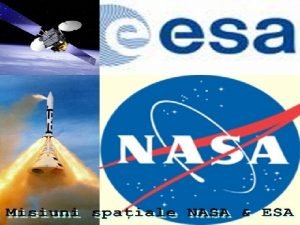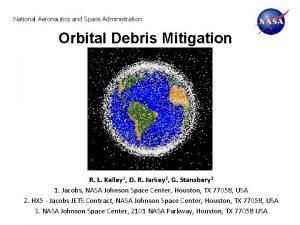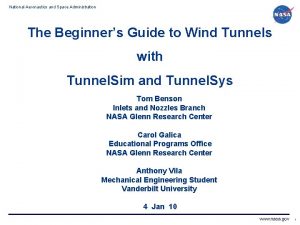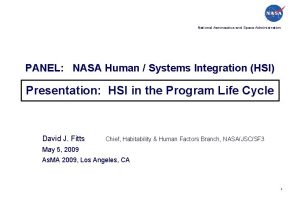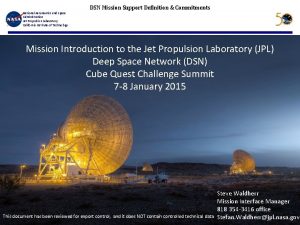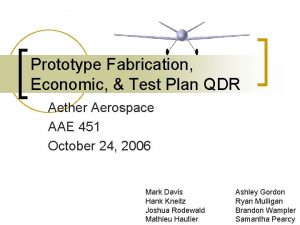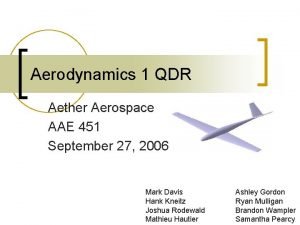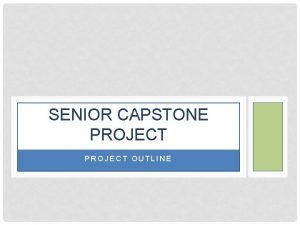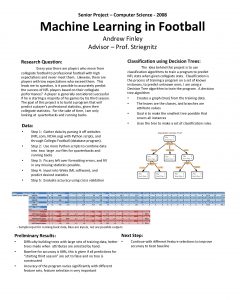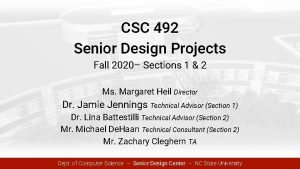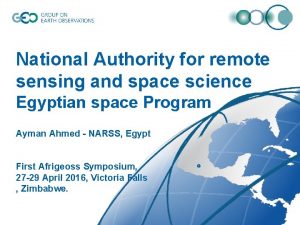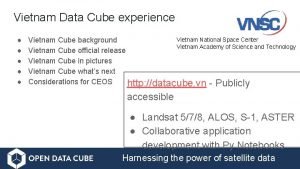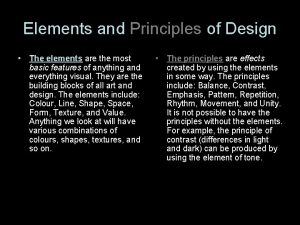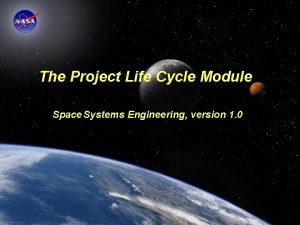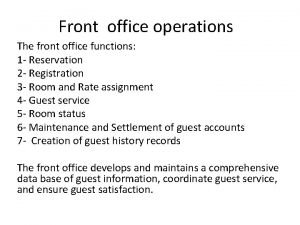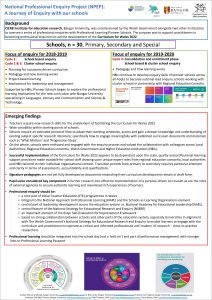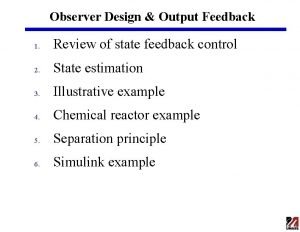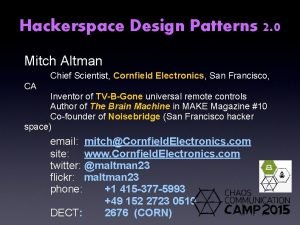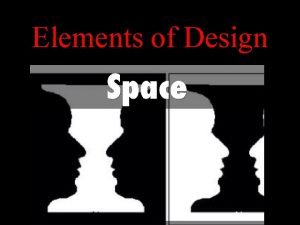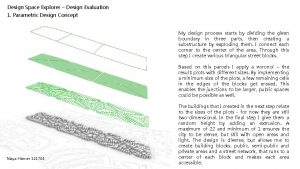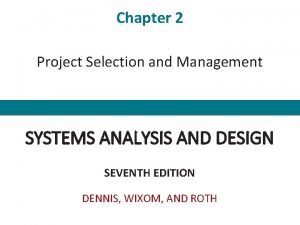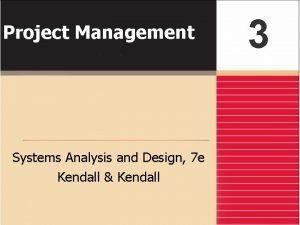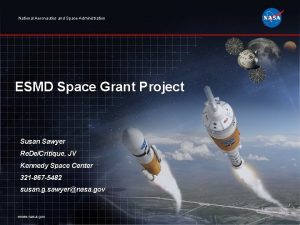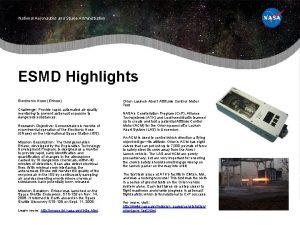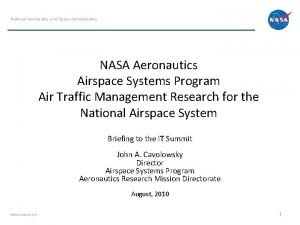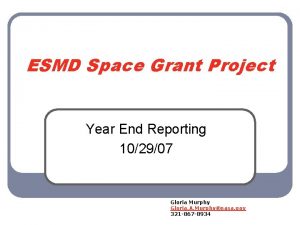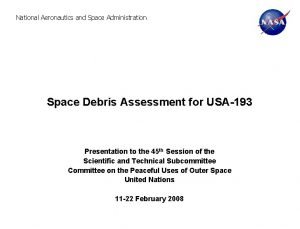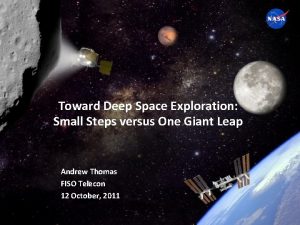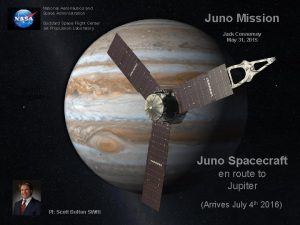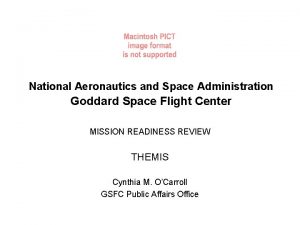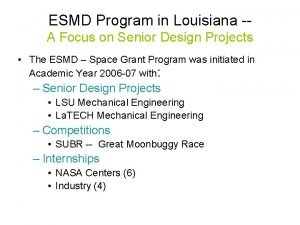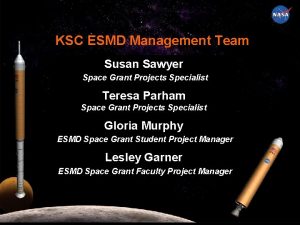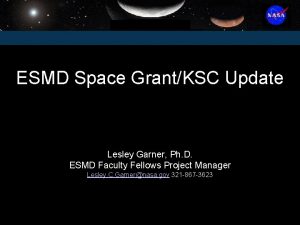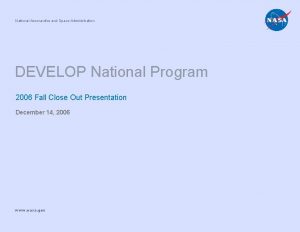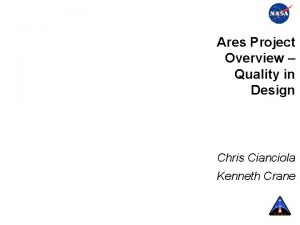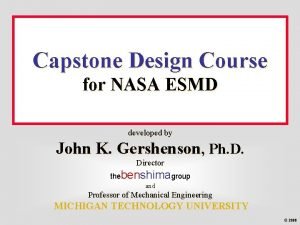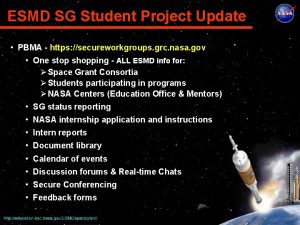ESMD Senior Design Project National Aeronautics and Space

































































- Slides: 65

ESMD Senior Design Project National Aeronautics and Space Administration Systems Engineering II: Design Tools Sellers: Chapters 11, 15 + Material From Auburn University Lunar Excavator Design Course, Courtesy of David Beale This section provides examples of systems engineering tools which may be needed during the design process. MAE 5930, Rocket Systems Design 1

Systems Engineering Applied to Sub. System Design Process (1) Subsystems Design 2 MAE 5930, Rocket Systems Design • Subsystem Design Process follows a distinct order and development hierarchy • Hmmmm. . Why is the propulsion System last on this chart?

Systems Engineering Tools Modeling and Simulation MAE 5930, Rocket Systems Design 3

Product Breakdown Structure Allows the systems engineer to systematically divide an entire project into a set of major production areas including, sub-areas, and sub-sub areas. MAE 5930, Rocket Systems Design 4

Work Breakdown Structure (2) -- An Alternative Viewpoint The first three WBS Levels are organized as: Level 1 – Overall System Level 2 – Major Element (Segment) – Subordinate MAE 5930, Level Rocket 3 Systems Design Components (Prime Items) 5

Work Breakdown Structure (WBS) Program -- WBS allows the systems engineer to systematically divide an entire project into a set of major tasks, sub-tasks, and sub-sub tasks. -- In this example, the tasks for fabrication of the attitude and orbit control system (AOCS) are broken into 5 sub-tasks. (Level 1 WBS) Fundamental Management Tool MAE 5930, Rocket Systems Design -- Each sub-tasks can be further sub-divided (Level 2 WBS) 6

Product Breakdown Structure (2) PBS for the SOFIA infrared telescope MAE 5930, Rocket Systems Design 7

Work Breakdown Structure (3) WBS for SOFIA Project MAE 5930, Rocket Systems Design 8

USU Chimaera WBS, 2008 -2009 MAE 5930, Rocket Systems Design 9

USU Chimaera WBS, 2008 -2009 (2) MAE 5930, Rocket Systems Design 10

Gantt Chart Bar chart that can be used to allot time to tasks, schedule reviews, and date milestones. . Complements WBS Microsoft Project Chart MAE 5930, Rocket Systems Design 11

Microsoft EXCEL Gantt Chart (2) MAE 5930, Rocket Systems Design 12

Design Reference Mission (DRM) One of the key enemies of a successful program is “mission creep” - That is a mission that continually adds requirements or changes direction - Mission creep more of ten not leads to a program “stalling” or collapsing altogether A tried and true way to keep a program on track is to design to a well defined mission: A “Design Reference Mission” (DRM) - DRM accomplishes top-level program requirements, but limits scope of design, and restricts unnecessary requirement growth USLI Sets a lot of the design reference for us. . But not entirely. . We define our Science mission… MAE 5930, Rocket Systems Design 13

Design Reference Mission (DRM) (2) Step 1: Define 2 (primary and secondary) Key mission objectives Step 2: Develop a mission strategy Step 3: Define phased operations and tasks Step 4: Bound the mission operating environment. Step 5: Identify desired outcomes Step 6: Identify available resources and Sustainability Step 7: Assess and develop plan for mitigating mission risk Step 8: Create a Mission Timeline Event and Concept of Operations MAE 5930, Rocket Systems Design 14

Design Reference Mission (DRM) (3) A DRM begins with a point of origination and terminates with a point of destination. With the end to end boundaries specified, the DRM defines how the project gets from the point of origination to the point of destination. The DRM strategy develops a mission profile that charts the progress through one or more staging or control points, called waypoints. A waypoint represents a geographical location, a point in time, or objective to be accomplished as an interim step towards the final destination. Each phase of operation is decomposed into one or more objectives focused on the roadmap to successfully reaching the final destination. MAE 5930, Rocket Systems Design 15

Design Reference Mission (DRM) (4) Developing a DRM Timeline or Roadmap MAE 5930, Rocket Systems Design 16

Example DRM, Apollo Lunar Landing The Apollo LM powered descent trajectory design was established… as a 4 phase maneuver… First phase was a short-burn Hohmann transfer from the parking orbit to the powered descent altitude Next phase was constant, continuous thrust braking maneuver, designed primarily for the efficient propellant usage while reducing velocity from orbital speeds to speeds compatible for landing …. This phase used the most “gas” The braking phase terminated at the “high gate” condition, and initiated the third landing phase, called the approach phase. The term “high gate” is derived from pilot terminology for beginning the approach to an airport. Approach phase is designed for pilot visual (out the window) monitoring of the approach to the lunar surface. The final “landing” phase, begins at “low gate” conditions (again from pilot terminology) , and was designed to provide continual visual assessment of the landing site and to provide compatibility for the pilot takeover from automatic control for the final touchdown on the surface. “Apollo Lunar Descent and Ascent Trajectories”, NASA technical memorandum, NASA TM X-58040, March 1970, presented to the AIAA 8 th Aerospace Sciences Meeting, NY, 19 -21 January, 1970 MAE 5930, Rocket Systems Design 17

Example DRM, Apollo Lunar Landing (5) MAE 5930, Rocket Systems Design 18

Example DRM, Apollo Lunar Landing (4) Identifiable Waypoints. . Where do we use most of the propellant? How about energy management? Apollo DRM Waypoint Predominant Physics Altitude Velocity Lunar Orbit Insertion Keplerian 60 nm (1848. 79 km radius) 1. 629 km/sec (5343 ft/sec) Transfer Orbit Burn Hohmann Transfer 60 nm-50, 000 ft (1752. 84 km radius) 1. 607 km/sec 1. 695 km/sec (5273 ft/sec-5563 ft/sec) Braking Maneuver Constant Thrust, Oblate 50, 000 ft – 7000 ft surface 1. 695 km/sec-0. 164 km/sec (5273 ft/sec 525 ft/sec) High Gate Constant thrust, flat surface 7000 ft-500 ft 500 fps horizontal -200 fps vertical to -3 fps vertical Low Gate Variable thrust, rough surface moon 500 ft-0 ft -3 fps vertical, variable, small horizontal velocity Landing On the surface 0 ft 0! MAE 5930, Rocket Systems Design 19

Example DRM, Apollo Lunar Landing (6) … Houston, Tranquility Base here. The Eagle has landed! Roger, Tranquility. We copy you on the ground. You've got a bunch of guys about to turn blue. We're breathing again. Thanks a lot. The greater the uncertainty, then the more general your DRM must be MAE 5930, Rocket Systems Design 20

Concept of Operations (CONOPS) Short Verbal or graphic statement, in broad outline, of a commander's assumptions or intent in regard to an operation or series of operations. The concept of operations frequently is embodied in campaign plans and operation plans; in the latter case, particularly when the plans cover a series of connected operations to be carried out simultaneously or in succession. The concept is designed to give an overall picture of the operation. It is included primarily for additional clarity of purpose. Also called commander's concept or CONOPS. MAE 5930, Rocket Systems Design 21

CONOPS Example • As magnetosphere processes evolve during a geomagnetic disturbance, Hi. DEF E-field observations provide a detailed map • Constellation will utilize natural RAAN precession to transform cluster from initially densely packed • Hi. DEF mission proposed for in-situ simultaneous E“sting of pearls” to a field measurements globally distributed sensor using constellation of pico-satellites cluster MAE 5930, Rocket Systems Design 22

CONOPS Example 2 Projected Altitude 1 Target Altitude Projected Altitude 1 2 Dispersion Envelope 1 Dispersion Envelope 2 Altitude Correction 1 Altitude Correction 2 Target Altitude 2 3 Projected Altitude Final Target Altitude Correction 3 Waypoint Dispersion Envelope 3 Waypoint Final Dispersion Envelope Waypoint Launch Site • • Airbrake Deployments At Predetermined Altitudes Launch “high” and then control maximum altitude through successive application of airbrakes until desired energy state is reached Inertial navigation used during powered ascent and a Kalman filter used for navigation during coasting stage-both navigation algorithms were student designed and implemented MAE 5930, Rocket Systems Design 23

Trade Studies • Trade study is a tool used to help choose the best solution among alternatives. • Numerical values are given based on weight factors and a normalization scale for the evaluation criteria. • Evaluation criteria are important factors that are included intrade study. • Weight factors are used to dictate how important the evaluation criteria are relative to each other. • The choice of weight factors and normalization scale are extremely important to this process. • Normalization scale creates a constant interval scale that allows us to set a numerical for each of the evaluation criteria (e. g. cost, mass, volume, power consumption legacy, ease of use). MAE 5930, Rocket Systems Design 24

Trade Studies (2) Steps to a trade study 1. Define the problem. 2. Define constraints on the on the solutions. 3. Find 3 -5 solutions 4. Define evaluation criteria. 5. Define weight factors 6. Define normalization scale 7. Populate trade matrix 8. Rank the solutions MAE 5930, Rocket Systems Design 25

Trade Studies (3) Sample Pugh Decision Trade matrix • Decision matrix: a decision-support tool allowing decision makers to solve their problem by evaluating, rating, and comparing different alternatives on multiple criteria. . . Finding a “best” design • Prevents a team from “falling in love” with a flawed design or one not meeting all design constraints or objectives • Communication tool; builds consensus MAE 5930, Rocket Systems Design 26

Trade Studies (4) The Pugh Evaluation Process MAE 5930, Rocket Systems Design 27

Trade Studies (4) 3)Study Example – Comparison of Controllers for Cube. Sat MAE 5930, Rocket Systems Design 28

Engine Selection Trade Study MAE 5930, Rocket Systems Design

Maneuvering System – Initial Trades (2) • Rotor, Drive Mechanisms, and Power Component Selection Process • Matched Electronic Speed Controllers • Batteries Selected to Meet Brake Power • Brushless DC-motors, direct propeller Requirements drive MAE 5930, Rocket Systems Design 30

Modeling and Simulation Allows complex interactions to be Discovered prior to hardware commitments MAE 5930, Rocket Systems Design 31

Modeling and Simulation (2) Verification, Validation, and Accreditation are integral part of simulation and modeling process MAE 5930, Rocket Systems Design 32

Functional Block Diagrams Schematic Block Diagram (SBD) depicts hardware and software components and their interrelationships. Developed at successively lower levels as analysis proceeds to define lower-level functions within higherlevel requirements. Useful for developing Interface Control Documents (ICD’s) MAE 5930, Rocket Systems Design 33

LPSLRV Functional Elements Vehicle Jet Engine Propellers Structure Thrust Vectoring Power Avionics MAE 5930, Rocket Systems Design Controls 34 of 107

Power Distribution System Outer Platform Power System Distribution Diagram MAE 5930, Rocket Systems Design 35

Interface Control Document (ICD) -- ICD’s define how the block within the SBD schematic are actually “connected” --Interface control documents are a key element of systems engineering as they define and control interface(s) of a system, and bound its requirements. -- The purpose of the ICD is to communicate all possible inputs to and all potential outputs from a system for some potential or actual user of the system. -- An ICD should only describe the interface itself, and not the characteristics of the systems which use it to connect -- The function and logic of those systems should be described in their own design documents. MAE 5930, Rocket Systems Design 36

Interface Control Document (2) -- Allows Disparate groups to work integrate sub-systems without complete working knowledge of what is inside of the “black box -- In this way, independent teams can develop the connecting systems which use the interface specified, without regard to how other systems will react to data and signals which are sent over the interface. -- An adequately defined ICD will allow one team to test its implementation of the interface by simulating the opposing side with a simple communications simulator. MAE 5930, Rocket Systems Design 37

Interface Control Document (3) Example ICD MAE 5930, Rocket Systems Design 38

Interface Control Document (4) Example ICD MAE 5930, Rocket Systems Design 39

Power and Mass Budget Analysis Weight and Power growth are major enemies of any spacecraft Power and Mass Budget Analyses Insure spacecraft growth is bounded and eventually mandates comes in “under weight” and “overpowered” Example MAE 5930, Rocket Systems Design 40

Power and Mass Budget Analysis (2) Example MAE 5930, Rocket Systems Design 41

Failure Modes and Effects Analysis (FMEA) -- A failure modes and effects analysis (FMEA) is a procedure for analysis of potential failure modes within a system for classification by severity or determination of the effect of failures on the system. --FMEA provides an analytical approach, when dealing with potential failure modes and their associated causes. Failure mode: The manner by which a failure is observed; it generally describes the way the failure occurs. “ Failure effect: Immediate consequences of a failure on operation, function or functionality, or status of some item MAE 5930, Rocket Systems Design 42

“Failure Mode Criticality Analysis (FMCA) MAE 5930, Rocket Systems Design (1) 43

“Failure Mode Criticality Analysis (FMCA) (2) Hazard Assessment Matrix Risk matrices provide assistance in managing and communicating risk. Qualitative and semi-quantitative measures of likelihood with similar measures of consequences. Track the status and effects of risk- handling efforts, And precisely Communicate risk status information. MAE 5930, Rocket Systems Design 44

“Failure Mode Criticality Analysis (FMCA) (2) Hazard Assessment Matrix Low (Green) Risk: Low potential for cost increase, schedule disruption, or performance degradation. . . acceptable risk. Moderate (Yellow) Risk: May cause some cost increase, schedule disruption, or performance degradation. Special action and management attention may be required to handle risk. High (Red) Risk: Likely to cause significant cost increase, schedule disruption, or performance degradation Significant additional action and high-priority management attention will be required to handle risk. MAE 5930, Rocket Systems Design 45

Flight Safety Hazard Assessment Matrix Risk Consequence: I II IV V - Failure Probability: A B C D E - Catastrophic, Loss of Vehicle, Death of Crew Severe, Significant Damage to Vehicle, Injury to Crew Minor Damage to Vehicle, Potential for Minor Crew Injury Loss of Mission Objectives Nuisance, Most Missions Objectives Accomplished No Mission Impact Likely (1 -- 1/10 ) Probable (1/10 -- 10 -2) Unlikely (10 -2 -- 10 -3) Very Unlikely (10 -3 --10 -5) Remote < 10 -5 Items in Yellow require NASA management Waiver, Shuttle flies with III, C & management waiver MAE 5930, Rocket Systems Design 46

Risk Assessment Example Hazard Tracking List Hazard Level 16 Hazard Causes Engine Failure, causing Debris an inability to keep Weather vehicle in air Temperature Burns from Jet Engine Exhaust Blowing debris Low-Voltage Electrical shock 9 Human Injury 8 Electronics Failure, Communication loss causing a loss of power Communication interference to rotors Electrical shorting 8 4 Vibration Effects, causing the vehicle to become unstable or components to become loose Fuel Leakage, forcing the time of the mission to be reduced Preventative Measures Screen on jet intake, Check flying conditions, Pre-flight checklist Pre-flight and in-flight systems check Wear protective equipment, Designate “Keep out” zones, No power during maintenance, Follow manufacturer’s recommendations, Follow checklists Pre-flight and in-flight systems check Rotors rotating near Resonance Pre/Post assembly testing Bad seal on Fuel Tank, Improper filling of Fuel Tank Quality check, Pre-flight checklist MAE 5930, Rocket Systems Design 4 7

Test Checklist DAY OF TEST (typical) 0400 Mx Prep 0600 Crew Brief 07: 30 Aircraft “Crew Ready” 07: 45 Aircrew Step to Aircraft 08: 15 Engine Start 08: 45 Taxi 09: 00 Takeoff MAE 5930, Rocket Systems Design

Test Checklist (2) THINGS TO THINK ABOUT • GO-NO-GO ITEMS • WEATHER • Equipment STATUS • Contingency Options • LIMFACS (bandwidth, test site availability, range availability) • CONTROL ROOM POSITIONS • COMM SETUP MAE 5930, Rocket Systems Design

Rapid Prototyping Rapid prototyping (RP) can be defined as a group of techniques used to quickly fabricate a scale model of a part or assembly using three-dimensional computer aided design (CAD) data. RP has obvious use as a vehicle for visualization. In addition, RP models can be used for testing, such as when an airfoil shape is put into a wind tunnel. RP models can be used to create male models for tooling, such as silicone rubber molds and investment casts. In some cases, the RP part can be the final part, but typically the RP material is not strong or accurate enough. MAE 5930, Rocket Systems Design 50

Rapid Prototyping (2) The reasons of Rapid Prototyping are To increase effective communication. To decrease development time. To decrease costly mistakes. To minimize sustaining engineering changes. To extend product lifetime by adding necessary features and eliminating redundant features early in the design. Rapid Prototyping decreases development time by allowing corrections to a product to be made early in the process. By giving engineering, manufacturing, marketing, and purchasing a look at the product early in the design process, mistakes can be corrected and changes can be made while they are still inexpensive. MAE 5930, Rocket Systems Design 51

Eight Rules for Prototyping 1 Recognize That Ideas Are Cheap – Given the connected, Internet-savvy world in which we live, ideas have become cheap and they will probably become cheaper with time. The expense lies in testing and verifying what has economic value. A great prototype is often the best way to start a dialogue with potential customers and test your idea’s value. 2 Start with a Paper Design – You may be eager to start coding or designing the electronics too quickly. Fight the urge. Writing code without real consideration for several design factors leads to heartache and a lot of rework. Start with a simple paper design. For a user interface or Web software prototype, a paper design is efficient and effective for quickly working through the functionality. You can get peers and, hopefully, customers to give feedback on where images, text, buttons, graphs, menus, or pull-down selections are located. Paper designs are inexpensive and more valuable than words. MAE 5930, Rocket Systems Design 52

Eight Rules for Prototyping (2) 3 Put in Just Enough Work – Know your objectives and stick to them. There are two good reasons to prototype: the first is to test the feasibility of a hardware or software architecture, and the second is to create a demonstration and gain customer feedback so you can price and put a value on your innovation. Keep these objectives in mind and be careful not to fall in love with the process. Prototyping is fun and innovators love to tinker, but you want to invest just enough time and work to meet the objectives. 4 Anticipate for Multiple Options – Design your prototype with modularity in mind. Great prototypes are often modular, which means you can quickly adapt them to meet customers’ unforeseen needs. Customers ultimately decide how to use your product, not you. Design in options for expansion, performance, packaging, and lower cost. MAE 5930, Rocket Systems Design 53

Eight Rules for Prototyping (3) 5 Design for Reuse in the Final Product – The ideal situation is to design a prototype you can produce and distribute in high volume. Not many prototyping tools can deliver on this promise. Typically you give up performance for design flexibility. Look for prototyping tools that make it possible for you to scale your prototype from lab to market. 6 Avoid Focusing on Cost Too Early – For hardware designs, a potential time sink and pitfall is getting caught up in endless cost optimization analysis during the early stages of your prototype design. Cost is always important, but your goal with a prototype is to be within striking distance of a profitable design. Initially, focus on proving the value of your innovation, and design with modularity in mind. While frustrating, your design may follow many paths that do not ultimately lead to value. Focus on securing your first set of customers and then work on cost optimization. MAE 5930, Rocket Systems Design 54

Eight Rules for Prototyping (4) 7 Fight “Reversion to the Mean” – When prototyping, the tendency is to develop something easy rather than develop something that has a “wow” factor. Stay true to your vision and make sure your prototype captures the original thought of your innovation. 8 Ensure You Can Demonstrate Your Prototype – Your prototype should be easy to demonstrate. With customers, venture capitalists (VCs), and potential employees, you want to start strong and show the most amazing capabilities first. Do not build up to a crescendo. Most people’s attention spans are limited to less than 60 seconds. In presentations, whether they are for a new employee or a VC, get to the demonstration as fast as possible. If the demonstration is amazing, all else falls into place. http: //zone. ni. com/devzone/cda/pub/p/id/579? metc=mtnxdy MAE 5930, Rocket Systems Design 55

Keys to Holding a Successful Meeting • Meetings are essential to any team effort, be it designing a rocket System, or launching a new cosmetic product • Done properly, meetings can quickly disseminate information, solve problems, create consensus, and get everyone “on the same page” • Done improperly, meetings can bog down, cause dissention, delay, and sometimes cripple a project. • Every meeting must a specific purpose – before arranging a meeting one need to think precisely about what it is that needs to be accomplished. MAE 5930, Rocket Systems Design 56

Keys to Holding a Successful Meeting (2) • Typical Meeting Purposes” Brainstorming new ideas Developing an idea or plan Having a progress update Technical interchange Considering options and making a collective decision Selling something to a potential buyer Building a relationship with somebody There may be a mixture of objectives and desired outcomes for a particular meeting, however, primary objectives should kept clearly in mind and those should prioritized above others. MAE 5930, Rocket Systems Design 57

Keys to Holding a Successful Meeting (3) 1. Invite the right people. Make sure these people attend. 2. Start with a clear objective for the meeting. Particularly with routine meetings, it's tempting to hold the meeting because it's “checking a box”, but what are you really trying to accomplish? People don't actually bond very much in unproductive meetings that lack clear objectives. 3. Set up a written agenda in advance. As you build the agenda, get real about how long it will take to address each topic. As a guideline, assume that if the goal is to make a decision, it will take four times longer than if the goal is to simply provide a status report. MAE 5930, Rocket Systems Design 58

Keys to Holding a Successful Meeting (4) 4. Formally track problem-solving and decision-making discussions. If everyone is in same room, use a flipchart or whiteboard, otherwise use electronic recording media. Appoint someone to take notes at the beginning of the meeting. Formally archive meeting notes in a data base with access to participating team members. 5. Formal Tracking Tools: a. Action Items – Requests for Action (RFA) Who is assigned action? When is action due? Who are action’s “customers” b. Information Items – Requests for Information (RFI) Who provided the information and verification? When is action due? Who needs the information MAE 5930, Rocket Systems Design 59

Keys to Holding a Successful Meeting (5) 6. Log and Track RFA, ’s RFI’s. . Don’t let people “off the hook” require that action forms be formally CLOSED. 7. End each meeting with a “consensus” check. Is everyone clear on assigned actions, and due dates. FORMALLY set a tentative time and date for a follow-up meeting, and who needs to be in attendance at this meeting. Log that follow up meeting time. MAE 5930, Rocket Systems Design 60

Technology Readiness Levels (TRL) • Designing sub-systems using high TRL components is a good way to reduce or mitigate programmatic risk. • High TRL systems have “heritage” and offer increased reliability and (hopefully) enhanced ease of integration. MAE 5930, Rocket Systems Design 61

Technology Readiness Levels (2) • Cardinal Sub-system Design Rules: Integrate when can (high TRL) Design and fabricate when you must Low TRL sub-systems require significant testing and evaluation before integration Low TRL’s can “fight” each other and have potential to seriously impact overall design budget and schedule! • High TRL systems have “heritage” and offer increased reliability and (hopefully) enhanced ease of integration. MAE 5930, Rocket Systems Design 62

Conceptual Technology Readiness Levels, 1 -5 MAE 5930, Rocket Systems Design 63

Prototype and Deployment Technology Readiness Levels, 6 -9 MAE 5930, Rocket Systems Design 64

Questions? ? MAE 5930, Rocket Systems Design 65
 National aeronautics and space administration
National aeronautics and space administration Space debris
Space debris Ee senior design project ideas
Ee senior design project ideas Mit aeronautics and astronautics
Mit aeronautics and astronautics Pioneer astronautics internship
Pioneer astronautics internship Tools of aeronautics
Tools of aeronautics Martin marietta aeronautics
Martin marietta aeronautics Tdot aeronautics
Tdot aeronautics Lm aeronautics
Lm aeronautics Define aeronautics
Define aeronautics Beginner's guide to aeronautics
Beginner's guide to aeronautics Aeronautics
Aeronautics Aeronautics definition
Aeronautics definition Hot air balloon thermodynamics
Hot air balloon thermodynamics Aether aeronautics
Aether aeronautics Aether aeronautics
Aether aeronautics Action plan for senior citizens
Action plan for senior citizens Pnac police
Pnac police Final project presentation template
Final project presentation template Senior project outline
Senior project outline Senior geography project
Senior geography project Capstone proposal outline
Capstone proposal outline Senior exit project examples
Senior exit project examples Machine learning senior project ideas
Machine learning senior project ideas Senior design ucf
Senior design ucf Ece senior design gatech
Ece senior design gatech Ncsu csc senior design
Ncsu csc senior design National space research and development agency
National space research and development agency National authority for remote sensing and space sciences
National authority for remote sensing and space sciences National unification and the national state
National unification and the national state Unscented trajectory chapter 5
Unscented trajectory chapter 5 Space junk the space age began
Space junk the space age began Camera space to world space
Camera space to world space Cartesian space vs joint space
Cartesian space vs joint space World space to screen space
World space to screen space Vietnam national space center
Vietnam national space center Design elements and principles of the universe
Design elements and principles of the universe Systems engineering life cycle phases
Systems engineering life cycle phases Occupancy stage in hotel
Occupancy stage in hotel Alonzo and tracy mourning senior high
Alonzo and tracy mourning senior high Department of health and senior services missouri
Department of health and senior services missouri Principles of computer input and output design
Principles of computer input and output design Arts council national lottery project grants
Arts council national lottery project grants National community college benchmark project
National community college benchmark project National standards project phase 2
National standards project phase 2 Science national honor society project ideas
Science national honor society project ideas National girls collaborative project
National girls collaborative project Npep wales
Npep wales National agricultural innovation project
National agricultural innovation project Elements of design assignment
Elements of design assignment What is problem space in hci
What is problem space in hci State space observer design
State space observer design Elements of design: space
Elements of design: space Repeating lines in a hairstyle.
Repeating lines in a hairstyle. Design space definition
Design space definition Hacker space design patterns
Hacker space design patterns Positive space in fashion design
Positive space in fashion design Design space explorer
Design space explorer Connecting rod diagram
Connecting rod diagram What are the project selection methods
What are the project selection methods Project management in system analysis and design
Project management in system analysis and design Crm project design and planning process
Crm project design and planning process Candidate system in system analysis and design
Candidate system in system analysis and design It analysis design and project management
It analysis design and project management The role of project management in achieving project success
The role of project management in achieving project success Example project background
Example project background
